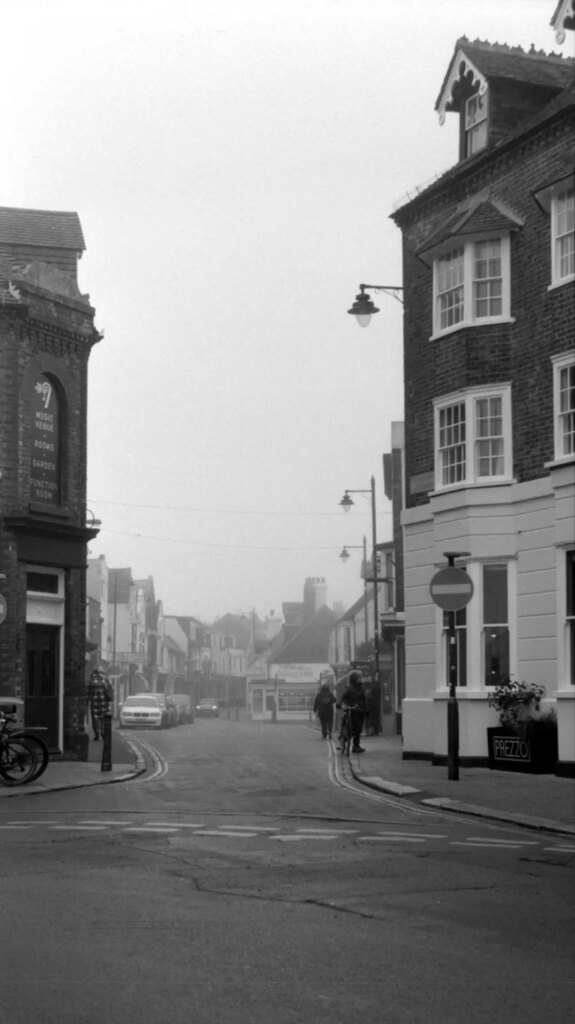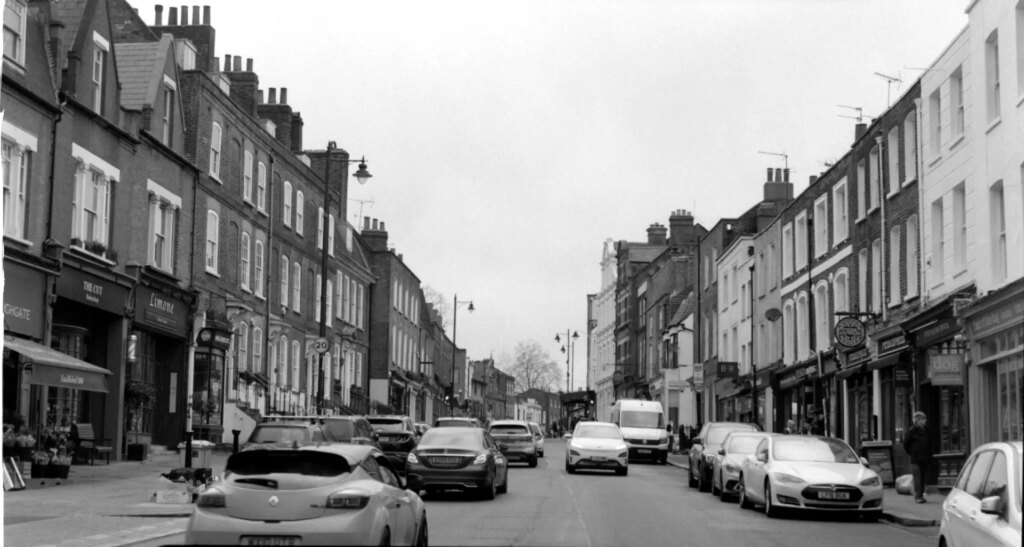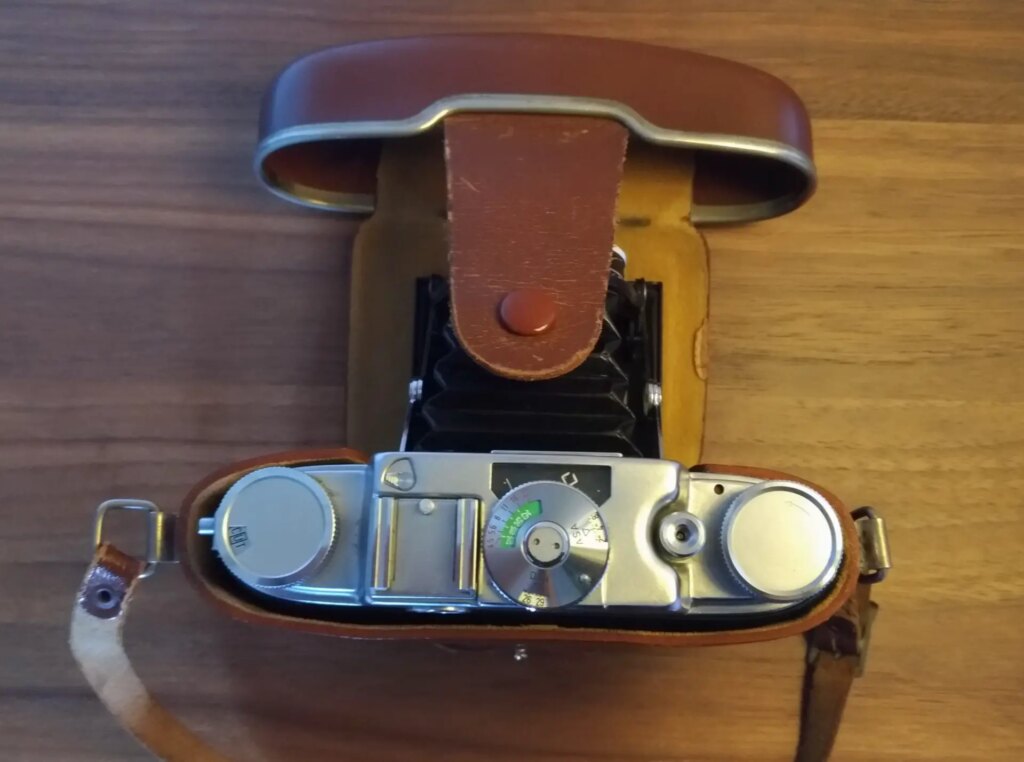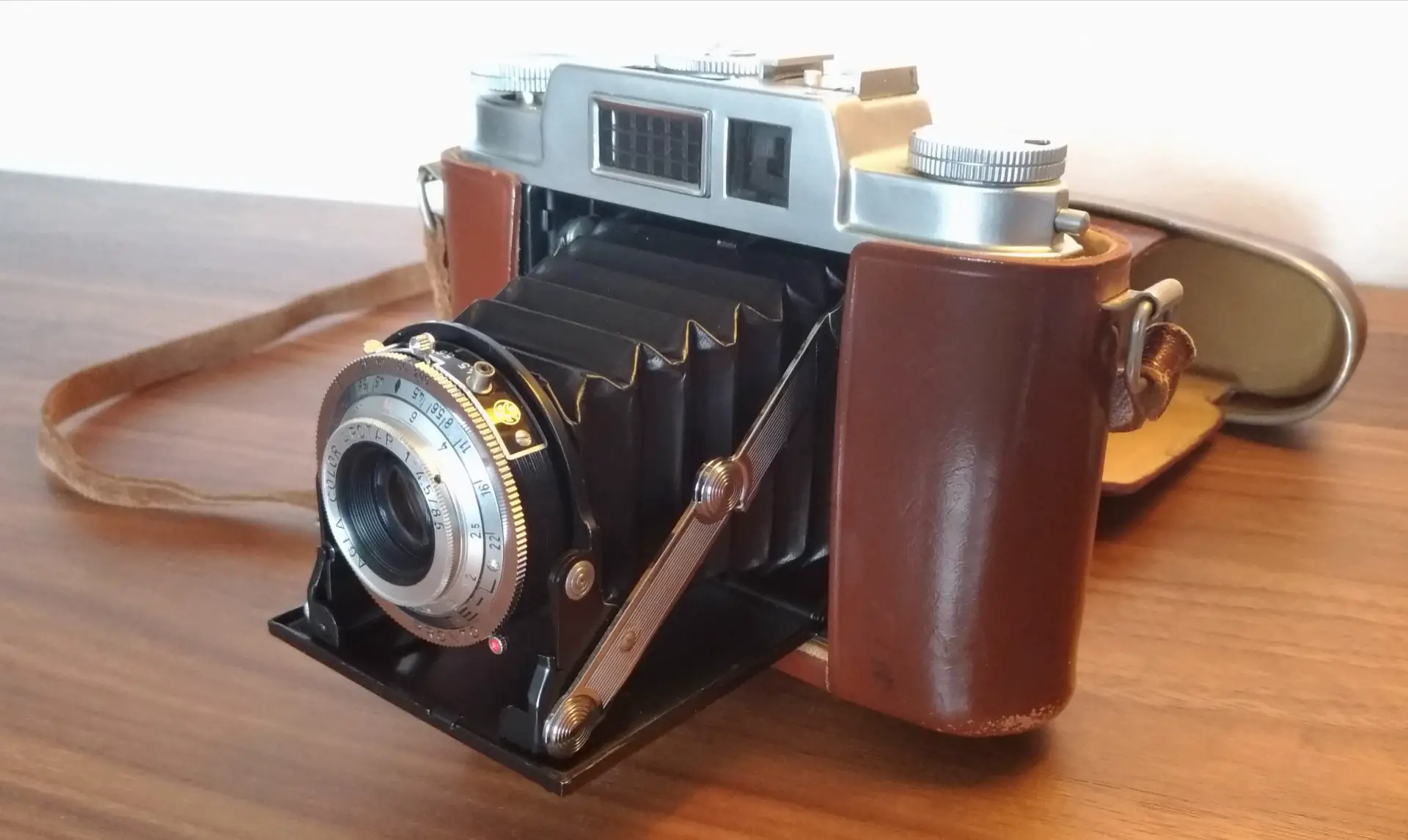Between 1937 and 1960 Agfa Kamerawerk AG, Munich, Germany produced a series of compact folding medium format (6×6) film cameras, the first being named the Isorette which was quickly changed to Isolette and then post WW2 to Jsolette and then back to Isolette. There were eight main versions and a couple of variants thereof, including those sold (and some made) in North America by Ansco as Speedex models.
The first version came with internal metal flaps that converted the camera from a 6×6 to a 6×4.5. There was also a viewfinder mask activated with a small lever.
All the models had one thing in common; the Agfa green grease used to lubricate the focussing helical. Many of the copies for sale via an internet search will either state the wholly pointless, irretrievably contradicting, ”Great condition. Untested” or the marginally more helpful ”Lovely camera. Focus stuck”. Over the decades, Agfa’s go to lubricant had dried out and turned almost solid, which relegated otherwise serviceable cameras to mere shelf displays. There are numerous desperate posts on line asking for help with freeing the helical and many well meaning replies, with some implying major surgery fraught with other dangers. After all, this is a bellows camera and you don’t want to slip and damage the bellows.
I guess at this point you may be wondering why such obscure information would be of any interest to this writer, so here’s the answer. About two years ago I saw a ”joblot” of three cameras for sale on line which included one that I wanted. Three cameras for £10 seemed manageable even if they were junk. One was indeed junk, to me, but I sold it to someone who could fix it. Good for them. That left me in at £2 each for the other two. Not bad. One of them was an Agfa Jsolette 4.5, the second iteration (1945-1950) and the first post WW2. No rangefinder, no light meter. A fully manual camera. The focussing was stuck. I read around, decided which information I could work with and which to avoid and I thought about it till the following morning. By lunchtime, I had managed to extract the lens section from the shutter, cleaned off the waxy green grease with a gentle solvent, re-lubed the helical with fine bike oil, collimated the focus and loaded a film. The results were great, all for £2 of camera, a bit of thought and a lot of luck.
About a year later I came across a piece about the Isolette L, 1957-1960 (www.120folder.com/agfa_isolette_l). The L stood for light meter (uncoupled) and this version had a nod back to the original; internal flaps, only this time to give an unusual 6×3 (tall portrait orientation) with a viewfinder mask to match. I had to have one. So I searched on line, as we do. It was at that point I discovered how rare they are. There were just two offerings. Two!! One was advertised as having a working focus, but the bellows looked very worn. The other looked a better proposition; pristine in the photos, light meter declared working, but the focus was stuck.
Ever tempted by a worthwhile challenge, I negotiated a suitable price for an apparently useless vintage photography item and waited for it to be delivered. Unboxing a camera of 60+ years in age only seen in photos, one never knows quite what to expect, but the seller had been honest and the photos didn’t lie. It was in great condition, no caveats bar the stuck focus. I examined the lens mount area. The 4.5 model mentioned above has a tiny locking screw that cannot be removed. It only rotates. One has to know to turn it to a precise point to extract the lens. There was no sign of it here. Agfa had made a slight design improvement so this lens would be easier to extract, possibly. I started my foundation work and within a few minutes managed to get a purchase on the focussing ring, turning it by hand, ever so gently and ever so slowly. Finally, the lens mount was out. Whoever was applying the Green Grease the day this camera was assembled so many decades ago, overstepped their remit. Never mind. It cleaned off all the mounting threads, eventually. With the main task completed, I oiled, reassembled and collimated.
So there it was, a beautiful Agfa Isolette L, restored to full mechanically functioning condition. It was a bright and sunny day with a wonderful blue sky, so I did the decent thing and loaded a roll of 120 film, choosing Fuji Pro 400H for its colour saturation.

Now, about those 6×3 flaps. Having finished the roll of Fujicolor, I waited for some grey skies to try out a roll of Fomapan 400. There was an associated risk; less light means wider apertures and likely less sharpness especially given this home collimator. I didn’t let that deter me, so with some care I turned the internal flaps into place and flicked the switch to move the viewfinder mask into position. Now, I am happy to be informed if anyone else knows better. There are certainly several medium format film cameras out there that offer a 6×4.5 mask but I have yet to find another 120 camera that has a 6×3 option. Here are a couple of example results. Yes, they could be sharper and maybe that’s my collimating or maybe it’s the glass. I’m going to be using the camera in good day light most of the time so I’m not going to fret about these parameter testing images.


So, as you can see, the the 6×3 flaps produce either a tall portrait, which I find rather impressive, or, by simply rotating the camera 90 degrees, a pleasing landscape.
I realised that in 6×3 mode the images would be half the width of the standard 6×6, so I estimated ahead how the film would advance and didn’t follow the numbering on the back of the film. In the end I managed to get 15 separate images from a roll of what would have normally provided 12. Suffice to say that this experiment is still in process. My ambition is for 20 shots.

Before I conclude, I’d like to to direct your attention to the above image of the camera, or more specifically the case. The camera did not come with this one. It came in a standard Agfa Isolette case which had been crudely adapted to accommodate this model. It would never have fit properly, because of the light meter. In fact there is only one correct case for the Agfa Isolette L and I had to buy it separately from a chap advertising his Agfa Isolette 4.5 (in that wrong case, of course). The bottom line is, if the case hasn’t got a metal rim around the lid it’s not the right one for the L.
In summary, the Agfa Isolette L is a pleasure to carry and use. It’s very grab-and-go. The uncoupled light meter is sufficiently accurate and helpful. I am very happy with the results the camera has produced and it’s staying in my collection. I’m looking forward to taking it out again this the coming summer.
David Lederman
London U.K.
instagram.com/photopia.passion.obsession
Footnote on the 6×3 mask: Having worked out how far to advance the film, using old backing paper, I managed to get 22 images out of a 120 roll. I paid no attention to the film numbering until the very end of the roll.
Share this post:









Comments
Simon on Agfa Isolette L – I Dared to Repair… and Won!
Comment posted: 03/05/2023
Comment posted: 03/05/2023
John Earnshaw on Agfa Isolette L – I Dared to Repair… and Won!
Comment posted: 03/05/2023
I must admit I've not used mine for a couple of years and really must dust it off and take it out.
Comment posted: 03/05/2023
Murray on Agfa Isolette L – I Dared to Repair… and Won!
Comment posted: 04/05/2023
Not only an uncommon camera, but an Agfa having a usable bellows is unusual, in my opinion.
The only one I have ever owned with a usable bellows was one of the black Trolitan (cousin of Bakelite) top Jsol- with the f/6.3 triplet.
Stripped heads of the dog screws wrestling the green grease, found Japanese metric screws (different thread pitch or angle-dont care, they worked), then discovered the lens had been reassembled in wrong order...focus was ~1/4" (~6 mm) behind the film plane. 2 or 3 tries & it focuses correctly now. Some day/month/year I have to try it with film.
I use synthetic grease for everything because I was given a 1# can.
I think the older (pre-WWII) Agfa's might have used real leather before the self-destructing material.
EVERY other Agfa & Speedex I own has bad bellows. I had so many I gave away the lens & shutter (90 mm) from an Ansco Speedex...so of course that was one I found replacement bellows for :@(. Generosity killed my prospects of success there.
Thanks for the inspiration.
Last Agfa thread-jack anecdote (apologies)...I bought several '620 spools' years ago. They came with Agfa 'B2' film, in sealed packages. I didn't figure out what it was so I tried ISO 25. (OK, maybe it was ASA 25).
So why not use it? One went into a Kodak Medalist 2. It was so perma-curled it cracked, halfway thru the roll...couldn't wind forward or backward...took to a lab & let them pick it out for me. Got some images.
I told the 'spools' seller of my success and he really seemed stunned- he said he had no intention of implying it was usable - he was just (admittedly) too lazy to take the film off the spools. He was sure it wasn't worth any further effort.
Ibraar Hussain on Agfa Isolette L – I Dared to Repair… and Won!
Comment posted: 05/05/2023
Comment posted: 05/05/2023
Stephen whited on Agfa Isolette L – I Dared to Repair… and Won!
Comment posted: 25/05/2023
Comment posted: 25/05/2023
Peggy on Agfa Isolette L – I Dared to Repair… and Won!
Comment posted: 01/06/2023
Comment posted: 01/06/2023